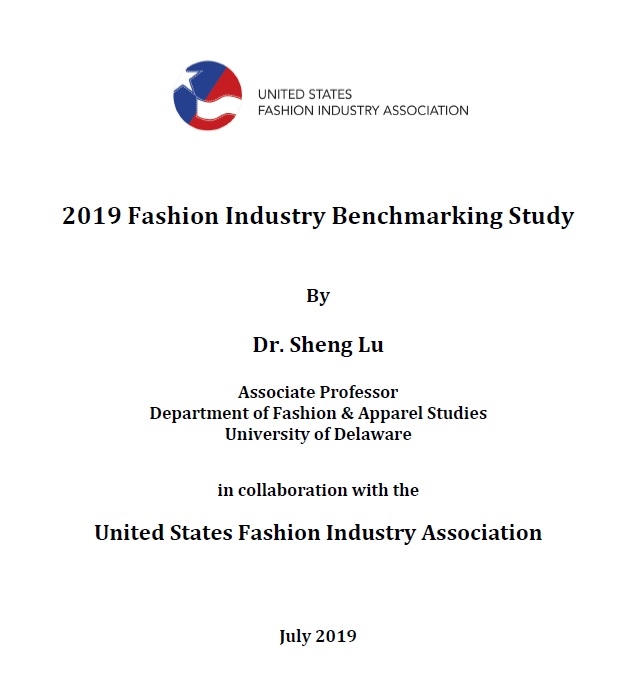The 2020 USFIA Fashion Industry Benchmarking Study is now available.
The full report is available HERE
Key findings of this year’s report:
Impact of the U.S.-China tariff war on sourcing:
- The trade diversion effect of Section 301 has accelerated U.S. fashion companies’ pace of reducing sourcing from China. About 83 percent of respondents expect to decrease sourcing from China over the next two years, up further from 67 percent in 2018.
- The Section 301 action is pushing up the price of U.S. apparel imports across the board, making “increasing production and sourcing cost” the top business challenge for respondents in 2019. As much as 63 percent of respondents explicitly say the U.S. Section 301 tariff action against China “increased my companies’ sourcing cost” in 2019. As companies are moving sourcing orders to Bangladesh, Vietnam, and India, the average price of U.S. apparel imports from these countries – the main alternatives to China — have all gone up by more than 20 percent in 2019 (January-May) year on year.
- No evidence shows that Section 301 has benefited near-sourcing from the Western Hemisphere and reshoring from the United States significantly. Instead, respondents say Section 301 has increased the production costs of textiles and apparel “Made in the USA.”
- Respondents say they are reluctant but may have to increase their retail prices, should the U.S.-China tariff war escalate further.
U.S. fashion companies’ latest sourcing strategy:
- Most respondents maintain a relatively diverse sourcing base, with 57 percent currently sourcing from 10+ different countries or regions in 2019. Around 83 percent of respondents say they plan to source from the same number or more countries over the next two years. Asia as a whole continues to take the lead as the dominant sourcing base for U.S. fashion companies.
- “China plus Vietnam plus Many” is still the most popular sourcing model among respondents. However, its details are evolving. However, different from the past, China is no longer always the top supplier for U.S. fashion companies. Around 25 percent of respondents indicate that they source MORE from Vietnam than from China in 2019, an emerging trend important to watch.
- This year, Vietnam remains the #2 sourcing destination among respondents, with a 86 percent usage rate. However, just around 7 percent of respondents plan to substantially increase apparel sourcing from Vietnam over the next two years, which reflects concerns about Vietnam’s limited production capacity and the increasing cost of sourcing from the country.
- Bangladesh is the #6 top sourcing destination, with 60 percent usage among respondents. A record high percentage of respondents (80 percent) express interest in expanding sourcing from the country in the next two years. Despite the price advantages, however, respondents still see Bangladesh not as attractive as many of its competitors regarding speed to market, flexibility & agility, and risk of compliance.
Outlook for sourcing from China:
- Despite the lingering tariff war, China will remain a dominant textile and apparel supplier for the U.S. market in the near future. Only 6.7 percent expect to decrease sourcing from the country significantly in the next two years.
- China does not have a near competitor in terms of the variety of product it can make.
- Considering speed to market, sourcing cost, flexibility & agility and compliance risk, China is also one of the few “balanced” sourcing destinations that U.S. fashion companies can choose from.
- Around 50 percent of respondents further say their Chinese vendors “lowered their price to keep sourcing orders” in response to the trade tensions.
Reshoring and apparel “Made in the USA”:
- This year, the United States ranked #10 top sourcing base with 43 percent usage, the same as in 2018.
- “Made in the USA” apparel overall are treated as a niche product in U.S. fashion brands and retailers’ sourcing portfolio. The advantage of proximity to the market, which makes speedy replenishment for in-season items possible, is an important factor behind the more successful control of markdowns for “Made in the USA” products.
- Respondents also list a few disadvantages and challenges that prevent them from sourcing more “Made in the USA” products in the next five years, ranging from the high price, limitations in the fabric options to a shortage of skilled labor.
- Further, respondents say more information about U.S. based textile and apparel mills will be helpful to promote “Made in the USA” sourcing.
U.S.-Mexico-Canada Free Trade Agreement (USMCA):
- The majority of respondents (65.5 percent) want the U.S. Congress to pass USMCA; More than half of respondents explicitly say NAFTA is important to their business and they want a seamless transition from NAFTA to USMCA.
- S. fashion companies currently sourcing from the NAFTA region are more likely to use USMCA and vice versa.
- However, a good proportion of respondents (around 20 percent) admit they do not fully understand the rule changes in USMCA for textiles and apparel.
- Helping companies better understand the technical details of USMCA and reducing the uncertainty about its ratification will be essential to the future success of the agreement.
The US Fashion Industry Benchmarking Study from 2014 to 2018 can be downloaded HERE


2 thoughts on “2019 U.S. Fashion Industry Benchmarking Study Released”